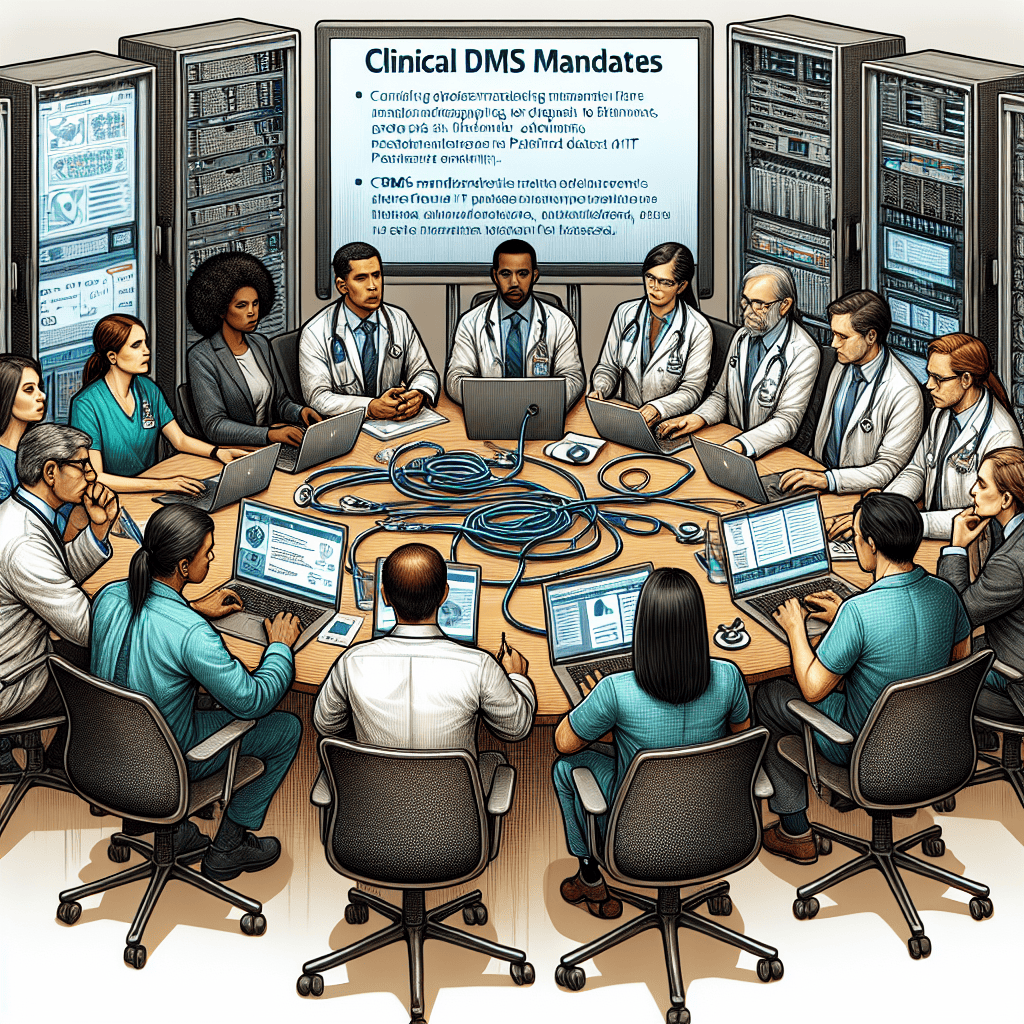Navigating CMS Mandates: Strategies for Clinical IT Leaders on Patient Data Access

In the rapidly evolving landscape of healthcare, the Centers for Medicare & Medicaid Services (CMS) mandates have become a pivotal force in shaping how patient data is accessed and managed. For clinical IT leaders, navigating these mandates is not just about compliance; it’s about leveraging them to enhance patient care, improve operational efficiency, and drive innovation. This article delves into the strategies that clinical IT leaders can employ to effectively navigate CMS mandates on patient data access, providing a comprehensive guide to understanding and implementing these requirements.
Understanding CMS Mandates: A Foundation for Compliance
Before diving into strategies, it’s crucial to understand the CMS mandates themselves. These regulations are designed to ensure that patient data is accessible, secure, and used to improve healthcare outcomes. The mandates cover a wide range of areas, including interoperability, patient access to health information, and data privacy and security.
One of the key components of CMS mandates is the Interoperability and Patient Access final rule, which aims to give patients better access to their health information and improve interoperability among healthcare providers. This rule requires healthcare providers to make patient data available through standardized APIs, enabling patients to access their health information using third-party applications.
Another important aspect of CMS mandates is the emphasis on data privacy and security. Healthcare organizations must ensure that patient data is protected from unauthorized access and breaches, complying with regulations such as the Health Insurance Portability and Accountability Act (HIPAA).
Understanding these mandates is the first step for clinical IT leaders in developing strategies to comply with them. By having a clear grasp of the requirements, IT leaders can identify the areas where their organizations need to focus their efforts and allocate resources effectively.
Key Components of CMS Mandates
- Interoperability and Patient Access final rule
- Data privacy and security requirements
- Standardized APIs for patient data access
- Compliance with HIPAA regulations
By understanding these components, clinical IT leaders can begin to develop a roadmap for compliance, ensuring that their organizations are well-prepared to meet the demands of CMS mandates.
Implementing Interoperability: Bridging the Data Gap
Interoperability is a cornerstone of CMS mandates, and for good reason. It enables seamless data exchange between different healthcare systems, improving care coordination and patient outcomes. However, achieving interoperability is no small feat, and clinical IT leaders must navigate several challenges to make it a reality.
One of the primary challenges is the lack of standardized data formats and protocols. Healthcare organizations often use different electronic health record (EHR) systems, each with its own data structure and communication protocols. This lack of standardization makes it difficult to exchange data between systems, hindering interoperability.
To address this challenge, clinical IT leaders can adopt standardized data formats and protocols, such as Fast Healthcare Interoperability Resources (FHIR). FHIR is a set of standards developed by Health Level Seven International (HL7) that enables the exchange of healthcare information between different systems. By implementing FHIR, healthcare organizations can ensure that their data is compatible with other systems, facilitating interoperability.
Another strategy for achieving interoperability is to leverage health information exchanges (HIEs). HIEs are organizations that facilitate the exchange of health information between different healthcare providers. By participating in an HIE, healthcare organizations can access a broader network of patient data, improving care coordination and patient outcomes.
Strategies for Achieving Interoperability
- Adopt standardized data formats and protocols (e.g., FHIR)
- Participate in health information exchanges (HIEs)
- Implement APIs for seamless data exchange
- Collaborate with other healthcare providers to align data standards
By implementing these strategies, clinical IT leaders can bridge the data gap and achieve interoperability, ensuring that their organizations are well-positioned to meet CMS mandates and improve patient care.
Enhancing Patient Access: Empowering Patients with Their Data
One of the primary goals of CMS mandates is to empower patients by giving them better access to their health information. By providing patients with easy access to their data, healthcare organizations can improve patient engagement, enhance care coordination, and drive better health outcomes.
To enhance patient access, clinical IT leaders can implement patient portals and mobile applications that allow patients to view their health information, schedule appointments, and communicate with their healthcare providers. These tools not only provide patients with convenient access to their data but also enable them to take a more active role in managing their health.
Another strategy for enhancing patient access is to implement standardized APIs that allow third-party applications to access patient data. By providing patients with the ability to use third-party applications to access their health information, healthcare organizations can offer a more personalized and engaging experience, improving patient satisfaction and outcomes.
However, enhancing patient access also comes with challenges, particularly in terms of data privacy and security. Healthcare organizations must ensure that patient data is protected from unauthorized access and breaches, complying with regulations such as HIPAA.
Strategies for Enhancing Patient Access
- Implement patient portals and mobile applications
- Provide standardized APIs for third-party application access
- Ensure data privacy and security compliance
- Educate patients on how to access and manage their health information
By implementing these strategies, clinical IT leaders can empower patients with their data, improving patient engagement and outcomes while ensuring compliance with CMS mandates.
Ensuring Data Privacy and Security: Protecting Patient Information
Data privacy and security are critical components of CMS mandates, and for good reason. With the increasing digitization of healthcare, patient data is more vulnerable to breaches and unauthorized access than ever before. Clinical IT leaders must implement robust data privacy and security measures to protect patient information and comply with regulations such as HIPAA.
One of the primary strategies for ensuring data privacy and security is to implement strong access controls. By restricting access to patient data to only those who need it, healthcare organizations can reduce the risk of unauthorized access and breaches. This can be achieved through role-based access controls, which grant access based on an individual’s role within the organization.
Another important strategy is to implement encryption for data at rest and in transit. Encryption ensures that even if data is intercepted or accessed without authorization, it cannot be read or used. By encrypting patient data, healthcare organizations can protect it from unauthorized access and breaches.
In addition to access controls and encryption, healthcare organizations must also implement regular security audits and risk assessments. These assessments can help identify vulnerabilities and areas for improvement, ensuring that data privacy and security measures are up to date and effective.
Strategies for Ensuring Data Privacy and Security
- Implement strong access controls (e.g., role-based access)
- Encrypt data at rest and in transit
- Conduct regular security audits and risk assessments
- Educate staff on data privacy and security best practices
By implementing these strategies, clinical IT leaders can protect patient information, ensuring compliance with CMS mandates and safeguarding patient trust.
Leveraging Technology: Driving Innovation in Patient Data Access
While compliance with CMS mandates is essential, clinical IT leaders can also leverage these regulations to drive innovation in patient data access. By embracing new technologies and approaches, healthcare organizations can improve patient care, enhance operational efficiency, and stay ahead of the competition.
One of the key technologies driving innovation in patient data access is artificial intelligence (AI). AI can be used to analyze large volumes of patient data, identifying patterns and trends that can inform clinical decision-making and improve patient outcomes. By leveraging AI, healthcare organizations can gain valuable insights from their data, enhancing patient care and operational efficiency.
Another technology driving innovation is blockchain. Blockchain can be used to create secure, decentralized databases for patient data, ensuring that it is protected from unauthorized access and breaches. By implementing blockchain, healthcare organizations can enhance data privacy and security while improving interoperability and patient access.
In addition to AI and blockchain, healthcare organizations can also leverage cloud computing to improve patient data access. Cloud computing enables healthcare organizations to store and access patient data from anywhere, improving care coordination and operational efficiency. By embracing cloud computing, healthcare organizations can enhance patient care and stay ahead of the competition.
Technologies Driving Innovation in Patient Data Access
- Artificial intelligence (AI) for data analysis and insights
- Blockchain for secure, decentralized data storage
- Cloud computing for improved data access and coordination
- Internet of Things (IoT) for real-time data collection and monitoring
By leveraging these technologies, clinical IT leaders can drive innovation in patient data access, improving patient care and operational efficiency while ensuring compliance with CMS mandates.
Conclusion: Navigating CMS Mandates for a Better Healthcare Future
Navigating CMS mandates on patient data access is a complex but essential task for clinical IT leaders. By understanding the mandates, implementing interoperability, enhancing patient access, ensuring data privacy and security, and leveraging technology, healthcare organizations can not only comply with regulations but also drive innovation and improve patient care.
The strategies outlined in this article provide a comprehensive guide for clinical IT leaders to navigate CMS mandates effectively. By adopting these strategies, healthcare organizations can enhance patient care, improve operational efficiency, and stay ahead of the competition, ultimately contributing to a better healthcare future.





